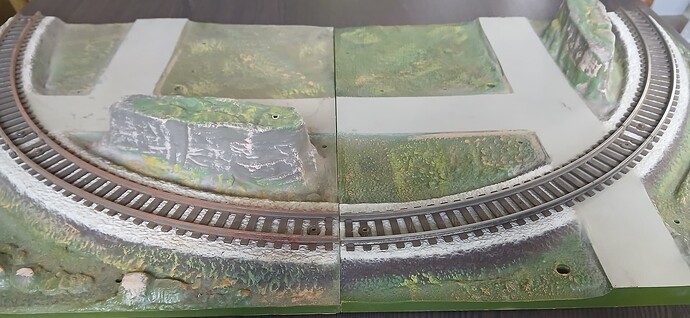My son-in-law inherited a well used Lionel train set from the 1920’s. The tracks are severely oxidized. Does anyone have any thoughts on how to clean/restore them to functional shape? I’ll deal with the engine and cars in a later post.
Congratulations to your son-in-law!
Depending just how oxidized (or badly rusted) the tracks are they can be cleaned with a Scotch-Brite pad. Only the surfaces that mate with the wheels and pick-up rollers need to have a good shine, the rest of the rails can be left as is or treated with a rust neutralizer.
If it’s an O Gauge set he can always purchase new track. If it’s Standard Gauge new track is also available but takes a little looking for.
Hi, had similar issue. Found a dremel with attachment a bit faster than scotch brite. But after a while I found a box of track cheap and that was even easier.
As mentioned, a Scotch Brite pad will take care of a lot of the things that will keep your trains from running. A carbon steel wire brush wheel in a Dremel tool can take care of the rest. One trick worth knowing is if you can remove the track pins they’ll fit into the standard size chuck of the Dremel tool and you can spin them slowly against a Scotch Brite pad to restore them quick and easy. Make sure all sections have all 3 pins on the same end and also inspect the little fiberboard insulators under the center rails.
Thanks. Some of the rail ends underneath, are starting to split. Should make remove the pins a little easier.
You may need to insert a flat head screwdriver into the web of the rail to open them up a little to get the pins out. But don’t worry, if you squeeze the web right at the bottom of the round railhead with a pair of needle nose pliers you can easily tighten them up again. Also, if you have a small strip of wood that fits under the ties you can tap the tie plates down with a screwdriver or metal rod tapped gently with a small hammer like a sculptor would do. Preventing the rails from spreading out of gauge is important too.
In Tom Barker’s AF Repair Guide, he used a large rock tumbler to clean tinplate track (this to clean all rail surfaces and even the ties). While he did this with Flyer track, I don’t believe there would be a difference if done to Lionel track. This is, however, assuming you want to clean the whole piece for cosmetic purposes, not just make it usable. As everyone else has stated, Scotch Brite would be perfect. I personally use a very fine grit sanding sponge and follow with a cloth dampened with rubbing alcohol, for both my standard Flyer track and my Pikemaster track.
We have resources for you:
I suspect maybe this could be a matter of debate, but there is a direct conflict presented in those 2 links.
I’d tend to agree with the guidance in the video with Hal (dated 2021) to not EVER use water when cleaning track, but that may just be me being cautious.
That second link to a Q/A from 2008 opens with the suggestion to soak the track in a laundry tub with water/detergent. Interestingly, it does link to a page that seems to be the text version of the video with Hal. Most of the rest in that link is probably very sound advice, but the water/detergent soaking part is questionable in my mind.
Haven’t seen that one before. I agree. Soaking in soapy water sounds like a bad idea if for no other reason than the damage it could cause to the center rail insulators.
I can see the water cleaning method for solid track with plastic ties (sleepers). The argument against doing this for Lionel hollow rail track makes sense in that it may degrade the center rail insulation and may take a very long time to completely dry out.
Yes. Wet fiberboard insulators would generate rust.
I’m counseling my son-in-law to throw away the track and buy new. The time needed to return these tracks to working condition isn’t worth it. Thanks everyone.
